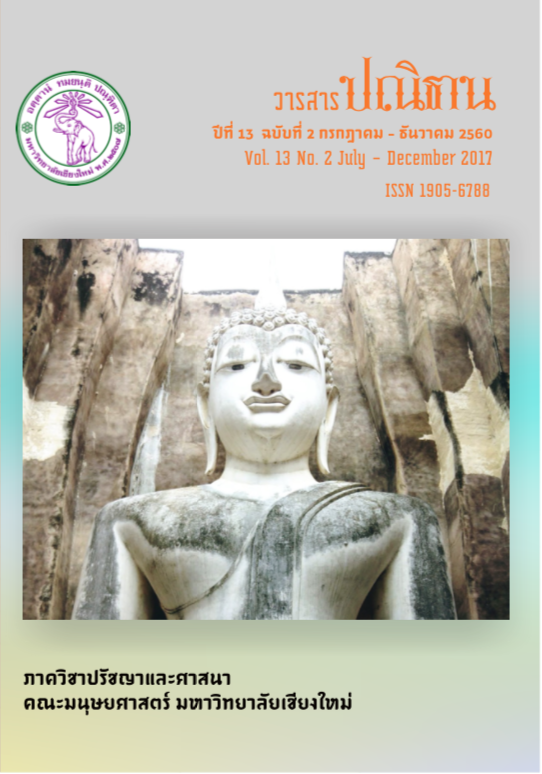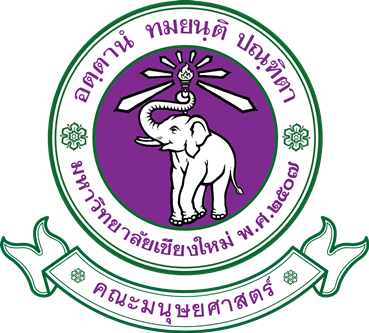รูปแบบหลักธรรมะที่เหมาะสมในกระบวนการสื่อข่าวของสื่อสังคม
คำสำคัญ:
สื่อสังคม, กระบวนการสื่อข่าว, หลักธรรมะที่เหมาะสม, รูปแบบหลักธรรมะบทคัดย่อ
สื่อสังคม มีบทบาทในการเป็นเครื่องมือที่เสริมเข้ามาในกระบวนการสื่อข่าวทุกขั้นตอน ของการสื่อข่าว ตั้งแต่การหาข่าวจนถึงการเผยแพร่ข่าว ซึ่งทำให้โลกของข่าวสารกว้างมากขึ้น ข้อมูลข่าวที่เคยจำกัดอยู่ในวงหนึ่งขยายกว้างมากขึ้น และผู้สื่อข่าวและกองบรรณาธิการ สามารถใช้ประโยชน์จากการสื่อสารสองทาง ผ่านเครือข่ายของกลุ่มผู้อ่าน ให้เกิดประโยชน์ในการสื่อข่าว ที่รอบด้านได้มากขึ้น ประเด็นสำคัญ ของการใช้งานสื่อสังคมของผู้สื่อข่าวไทยในปัจจุบัน คือ “มิติของความเร็ว” ที่สามารถรายงานข่าวได้ทันที หาข่าวได้เพิ่มเติมระหว่างการทำข่าว จากความสามารถในการโต้ตอบกับเครือข่ายในสังคมออนไลน์ ได้อย่างรวดเร็ว แต่ใน “มิติความลึก” ยังมีการใช้น้อย และยังไม่ชัดเจนว่าจะใช้งานในลักษณะใดบ้าง โดยมีข้อจำกัด ในเรื่องเวลา และความเข้าใจในรูปแบบการใช้เชิงลึก ในขณะเดียวกันการมีสื่อสังคม เป็นเครื่องมือสำคัญในกระบวนการสื่อข่าว
รูปแบบของหลักธรรมะในชุด (4 ก้าว) ที่ส่งผลสะท้อนต่อหลักธรรมะการแสดงตัวตน ควรนำศีล 5 มาปรับประยุกต์ใช้ตามโอกาส ทางเลือก การเปลี่ยนแปลง หลักธรรมะการตระหนัก ควรนำหิริโอตัปปะ มาปรับประยุกต์ใช้ตามความกล้า ความฝัน การกระทำ หลักธรรมะการเชื่อมต่อ ควรนำการสำรวมอินทรีย์ มาปรับประยุกต์ใช้ตามพฤติกรรม การเปลี่ยนแปลงของสิ่งต่างๆ หลักธรรมะการเอาใจใส่ ควรนำอิทธิบาท 4 มาปรับประยุกต์ใช้ตามศักยภาพ แรงจูงใจ และทัศนคติ ซึ่งการใช้ “การสร้างกระแส”สามารถพบเจอได้ตามสื่อบนโลกออนไลน์ ดังนั้นก่อนแสดงความคิดเห็นใดๆ โดยเฉพาะทางสื่อออนไลน์ที่ส่งผลกระทบแพร่กระจายอย่างรวดเร็วผู้ใช้ยิ่งควรตรวจสอบและกลั่นกรองข้อมูลก่อนตอบโต้แสดงความคิดเห็น
เอกสารอ้างอิง
ส่วนบุคคลนี้ เป็นสวนหนึ่งของการอบรมหลักสูตร “ผู้บริหารการสื่อสารมวลชนระดับกลาง (บสก.) รุ่นที่ 2” สถาบันอิศรามูลนิธิพัฒนาสื่อมวลชนแหงประเทศไทย
โรม วงศ์ประเสริฐ. (2560). แนวคิดทฤษฏีเกี่ยวกับการสื่อสารแบบปากต่อปาก. ม.ศิลปากร. ค้นเมื่อวันที่
1 สิงหาคม 2560 จาก
http://1sssu2.igetweb.com/index.php?mo=23&node=3441&c=1073&lang=.
พระณัฏฐวัฒน์ าณปฺปโภ (ตั้งปฐมวงศ์). (2558). รูปแบบการเรียนรู้เพื่อพัฒนาพฤติกรรมการใช้
สื่อดิจิทัลตามหลักพระพุทธศาสนา. ดุษฎีนิพนธ์. พุทธศาสตรดุษฎีบัณฑิต. สาขาวิชาพระพุทธศาสนา.บัณฑิตวิทยาลัย. มหาวิทยาลัยมหาจุฬาลงกรณราชวิทยาลัย.
สกุลศรี ศรีสารคาม. (2554). สื่อสังคม (Social Media) กับการเปลี่ยนแปลงกระบวนการสื่อ
ข่าว. รายงานวิจัย. ศูนย์วิจัย มหาวิทยาลัยธุรกิจบัณฑิตย์.
Alejandro, Jennifer (2010). Journalism in the age of social media. Reuters Institute
of the study of journalism, University of Oxford.
Bokor, T. (2014). More Than Words, Brand Destruction in the Online Sphere.
Vezetéstudomány/Budapest Management Review, 45(2), 40-45.
Bruns, A. (2008). The Active Audience: Transforming Journalism from
Gatekeeping to Gatewatching. In Making Online News: The Ethnography of New Media Production. Eds. Chris Paterson and David Domingo. New York: Peter Lang.
Briggs, Mark.(2007). Journalism 2.0: How to Survive and Thrive. Open Access
Textbooks. Book 2. http://scholarcommons.usf.edu/oa_textbooks/2
Bakhurst, K. (2011) .How has social media changed the way newsrooms work?.
http://www.bbc.co.uk/blogs/theeditors/2011/09/ibc_in_amsterdam.html#moe
Bowman,S & Willis, C. We Media: How audience are shaping the future of news
and information.
http://www.hypergene.net/wemedia/download/we_media.pdf
Channel, Amani, (2010). Gatekeeping and citizen journalism: A qualitative
examination of participatory newsgathering. Theses and Dissertations. Paper 1598 : http://scholarcommons.usf.edu/etd/1598
David Gilbert, Liz Lee-Kelley and Maya Barton. (2003) .Technophobia, gender
influences and consumer decision-making for technology-related products European. Journal of Innovation Management. 6(4), 253-263.
Deuze, M (2003). The Web and its Journalism: Considering the Consequence of
Different Types of News media online. New media & Society Journal Vol5: 203-230.
Gilmor, D. (2006). We the Media: Grassroots Journalism by the People, for the
People. OReilly : New York.
Harper, Christopher. (1998). And That's the Way It Will Be: News and Information
in a Digital World. New York: New York University Press.
Jarvis, J. (2006). New worked journalism. Retrieved on October 23, 2009, from
http://www.buzzmachine.com/2006/07/05/networked-journalism
JOHN V. PAVLIK. (1999). New Media and News: Implications for the Future of
Journalism. New Media & Society. April 1999 (1), 54-59.
Lasica, J. D. (2003). Blogs and Journalism Need Each Other. Nieman Reports
57(3).
Miel & Faris (2008). News and information as digital media come of age:
http://cyber.law.harvard.edu/sites/cyber.law.harvard.edu/files/Overview_MR.pdf Newman, Nic. “The rise of social media and its impact on mainstream journalism.”
Nip, J. (2006). Exploring the Second Phase of Public Journalism. Journalism
Studies. 7 (2), 212-236.
O’Connor, Rory. Facebook and Twitter Are Reshaping Journalism As We Know
It. Alternet. 20 Jan. 2009. Web. 26 Feb. 2010.
Pavlik, John. (1999) . Journalism and New Media. New York: Colombia University
Press.
Paul Bradshaw. (2007). A model for the 21st century newsroom: pt1 – the news
Diamond.:http://onlinejournalismblog.com/2007/09/17/a-model-for-the-21st-centurynewsroom-pt1-the-news-diamond/.
Richard Gordon.(2009). Social Media: The Ground Shifts,' Nieman Reports
(Fall,2009):http://www.nieman.harvard.edu/reports/article/101883/Social-Media-The-Ground-Shifts.aspx
Robinson, S. (2006). The mission of the j-blog : Recapturing journalistic authority
online. Journalism Journal. 7(1), 65-83.
Shirkey, Clay. (2007). Here Comes Everybody. New York: The Penguin Press.
Singer J. (2004). Stepping Back From the Gate: Online Newspaper Editors and
the Co-Production of Content in Campaign 2004. Journalism and Mass
Communications Quarterly. 83 (2), 265-280.
Skoler, M (2009). Why the News Media Became Irrelevant—And How Social
Media Can Help. Nieman Reports (Fall) , 38-40,
http://www.nieman.harvard.edu/assets/pdf/Nieman%20Reports/backissues/Fall2009. pdf
Wendland, D. (2003). Blogging Connects a Columnist to Story Ideas. Nieman
Reports (Fall) : 94:
http://www.nieman.harvard.edu/assets/pdf/Nieman%20Reports/backissues/03fall.pdf.
ดาวน์โหลด
เผยแพร่แล้ว
รูปแบบการอ้างอิง
ฉบับ
ประเภทบทความ
สัญญาอนุญาต
เนื้อหาของบทความที่ได้รับการตีพิมพ์ในวารสารปณิธานถือเป็นลิขสิทธิ์ของวารสารปณิธาน ห้ามเผยแพร่ ตัดต่อ แก้ไข หรือนำไปใช้ก่อนได้รับอนุญาต
ผู้สนใจสามารถติดต่อขอเผยแพร่เนื้อหาในวารสารปณิธานได้ที่ panidhana-human@cmu.ac.th







